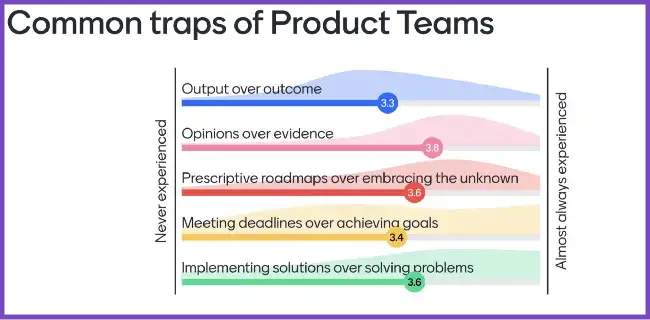Almost everything I loved as a kid has been replaced with a subscription service. The world I grew up in is seen as something retro today.

For instance, I’m a heavy metal fan. I collected CDs, exchanged them with friends, and was proud to own all the Iron Maiden albums. It took me a while to get there. Today, thanks to Spotify, anyone can access any album they want in seconds. Some teenagers don’t even know what a CD is.
Another example: once or twice a month, I’d go to Blockbuster to rent a movie. I’d walk there, select the movie I wanted to watch — and often be disappointed to find it’s not available. Today, you can search for and rent or purchase almost anything you’d want to watch directly from whatever you are. No stress, just press.
The bottom line is that industries are disrupting themselves and becoming digital in what feels like the blink of an eye. Within that, many opportunities emerge. That’s why you’ll always find many open positions to work with product teams.
But the speed at which industries have evolved also leaves plenty of room for product teams to fall into traps and engage in anti-patterns that hinder their efficiency and obstruct innovation. In this guide, we’ll break down some of the most common mistakes product teams make and walk through steps to help you revolutionize the way your team works.
The speed at which industries have been disrupted is hard to believe. Despite all this growth and innovation, however, many teams still work with a 1970s mindset.
What do I mean by that? I often give talks in different corners of the world. Before each talk, I want to have an overview of common anti-patterns and traps that the attendants often face. No matter which country I’m in, I get similar results. And they often shock me.
For example, the graph below breaks down feedback I gathered from an audience in Western Europe. Attendees cited the following scenarios that leave their product teams feeling stuck:
The further a team scores to the right, the more trapped it is:

I got almost the same results as in the USA, Eastern Europe, and the UK. Why do these things happen?
We’ve got a choice to make as product managers: you can bow to the status quo and remain stuck or step back, reflect, and challenge the anti-patterns that have mired your teams for years.
Let me help you find opportunities to change how you work for the better.
Courage is necessary to steer change. People dislike change because the unknown is frightening. Yet, you’ll get supporters if you’re brave and take a digestible approach.
You can start by helping people recognize the problem and its consequences. After that, you can talk about ways to improve, but not before.
Don’t tell your colleagues that they’re working incorrectly. Show them the anti-patterns and ask how often they face each one. Then, bring hope and position yourself as a guide to lead the transformation. When people connect to a problem, they need someone guiding them to solve it.
Here’s my method: name the anti-patterns you see and ask your colleagues to rate them. You can use any digital board to do this (e.g., Mentimeter, Miro, Mural, etc.).
The next question is, are we happy to stay this way forever?
Within that, you have the required openness to address the anti-patterns. Let me walk you through five inefficiencies I often face and how to overcome them:
How does your company measure success?
If you’re like most product teams, velocity, features, and deadlines are means to measure success. The problem is that none of them can guarantee you create value for your business.
Maybe you’re lucky and success means increasing an important KPI, such as customer satisfaction, return rate, conversation rate, etc. It doesn’t matter how many features you deliver, but how they change the ultimate result.
Most people think about outputs because it’s natural, and outcomes aren’t. Yet, you must focus on outcomes to create value.
You can do this by bringing the outcome to your conversations. Here are some examples:
It’s complicated to change your mindset from output to outcome, but it’s mandatory to create value.
Everyone has opinions about everything, and that’s fine. But letting opinions drive your decisions is bad. It’s critical to move away from opinions and get closer to evidence.
Product teams face this dilemma every day. Stakeholders want something because they think it’s cool, yet they haven’t talked to any users. Developers and designers often get into a dogfight, bring few facts to the table but many opinions.
When discussions are based on opinions, results are based on luck.
A better approach is to be mindful. If you believe something is incredible for your product but lacks evidence, what about experimenting to test your assumptions?
Let’s say, for example, a designer believes a complex adaption is required but has no evidence to convince developers. What about having an unmoderated prototype test and comparing different designs?
Evidence must talk louder than opinions to create a valuable product.
Good roadmaps set guardrails and let teams be creative. Bad roadmaps pressure teams to achieve the impossible without knowing why.
Most roadmaps leave no room for creativity. The reasons vary, from lack of trust to lack of understanding. As long as your roadmaps define what teams are to deliver, they have no chance of thriving.
Get together with top management and ask them to set different roadmaps. Encourage them to come up with goals that the product teams are accountable for, but build in the bandwidth to experiment with other solutions.
Some leadership teams will accept that, but most won’t. At that point, you can suggest trying an experiment: 20 percent of the next roadmap should be focused on a goal while the rest will be as it used to be.
When you have the chance to embrace the unknown, you increase the odds of creating outstanding solutions.
Let the results talk louder, and make incremental changes to your roadmapping approach.
Of the few things that could be worse than a prescriptive roadmap, one is a roadmap with deadlines set in stone. When that happens, teams will cut corners to meet arbitrary wishes.
What’s the problem with deadlines? It’s not the deadlines themselves, but how they’re set. Generally, someone outside the team defines deadlines, then asks for te team’s commitment. Of course, that won’t work. No one commits to something they weren’t part of planing for.
Collaboration is the answer to this puzzle. If leadership wants to meet a deadline for any reason, share that with the team.
For example, if the customer acquisition cost is too high, it needs to improve or increase customer lifetime value. Leadership might be afraid of running out of money, so they want this situation resolved in three months. Sharing that with the team would be enough.
A question like, “How might we change our situation in the next three months?” is a great start to crafting a valuable goal. This question enables the team to work backward and search for different options.
When your focus is on goals, results can surprise you in a positive way. But when your attention goes to meeting deadlines, quality suffers.
In previous decades, the higher your rank was, the more decisions you could make. Traditionally, high-ranking people tend to have little to no customer contact. Things have changed a lot since then.
Good leadership is about creating an environment where teams can work autonomously.
Unfortunately, some leaders misunderstand their roles and try calling all the shots. They have all the best ideas and want their teams to implement solutions as they say. Yet, teams don’t even know what problems they are solving.
You’ll inevitably stumble across leaders like that throughout your career as a product manager. You can win this battle not with arguments but with curiosity. Ask questions to understand the problem. For example:
Arguments annoy people, but curiosity will encourage them to reflect.
“Millions Saw the Apple Fall, but Newton Asked Why.” — Bernard Baruch
When you do the test I mentioned above, you may realize your product team has many anti-patterns. Don’t get overwhelmed — most teams haven’t had the chance to experience working differently. Take it as an opportunity to do something different.
The secret sauce to making any transformation work is as follows:
Transformation is an ultramarathon, not a 100-meter sprint. Go easy, but go continuously.

LogRocket identifies friction points in the user experience so you can make informed decisions about product and design changes that must happen to hit your goals.
With LogRocket, you can understand the scope of the issues affecting your product and prioritize the changes that need to be made. LogRocket simplifies workflows by allowing Engineering, Product, UX, and Design teams to work from the same data as you, eliminating any confusion about what needs to be done.
Get your teams on the same page — try LogRocket today.

Most teams fail at autonomy. Learn how clear rules help product teams move faster without micromanagement.

A practical framework for PMs to use AI in ideation without sacrificing judgment, strategy, or decision quality.

A practical five minute revenue estimation method to help product managers compare ideas, drop low impact features, and prioritize smarter.

A practical guide for PMs who want to stop being bottlenecks, delegate smarter, and lead teams effectively with a clear ownership framework.